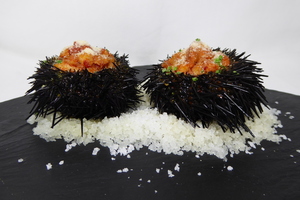Sea urchins
Category
Seafood
Seasonal period:
January, February, March, April, November, December
Allergens
They are found in rocks and they prefer to be close to the coastline.
They can be green, brown or purple. Their spikes can be as long as the shell. They cover themselves with shells, stones and algae as a self-defense mechanism and to avoid strong light.
Urchins’ edible parts are the orange stripes they have inside .They are highly appreciated.
Nutritional information (0.1 kg)
Energy
68.0
kcal
Carbohydrates
0.0
g
Proteins
16.5
g
Lipids
0.3
g
Sugars
0.0
g
Salt (Sodium)
0.0
mg
Folic acid
0.0
ug
Vitamin C
0.0
g
Vitamin A
0.0
ug
Zinc
0.0
mg
Iron
0.0
mg
Calcium
0.0
mg
Cholesterol
0.0
mg
Polyunsaturated fatty acids
0.0
g
Monounsaturated fatty acids
0.0
g
Saturates
0.0
g
Fiber
0.0
g
The data is merely a guide and should not be used for medical purposes. Those responsible for the web disclaims any responsibility.
-
Type of dish
- Beers
- Cocktails
- Breakfasts and brunch
- Burguers
- Juices, milkshakes and beverages
- Shellfish
- Bread and pastries
- Pizzas, patty
- Dessert
- Pasta
- Sándwich
- Pastries
- Finger foods
- Ice creams and sorbets
- Legumes
- Salads
- Eggs
- Patty
- liqueur
- Harvard plate
- Main course
- Meats
- Fish
- Birds
- Vegetables
- Soups and creams
- Rices
- Coffee, chocolate and infusion
- Cheeses
- Appetizers and canapes
- Temperature
- Cuisine type
- Additional culinary preparation
- Conservation technique
- Seasonal recipes
-
- Aromatic herbs
- Beverages
- Big game hunt
- Bread and pastries
- Canned goods and pickles
- Cereals
- Condiments, spices and additives
- Cooked, salted, preserved and cold meats
- Dried fruits and nuts
- Dry pulses
- Edible oils and vinegars
- Eggs and derivatives
- Feathered game hunt
- Fish cuts
- Fishes
- Insects
- Kitchen and bakery tecniques
- Kitchen and bakery utensils
- Meat cuts
- Meats
- Milk, cream and derivatives
- Mushrooms
- Offal
- Pasta, rice, flour and derivatives
- Poultry
- Seafood
- Service techniques
- Service utensils
- Vegetables cuts
- Vegetables, fruits, tubers and seaweed


